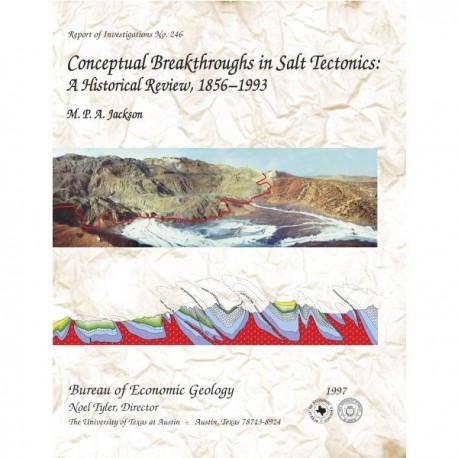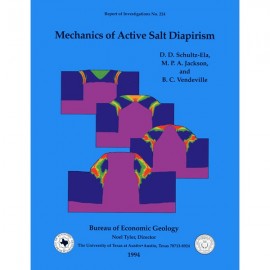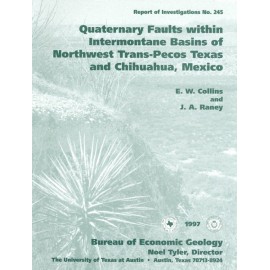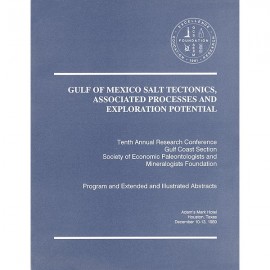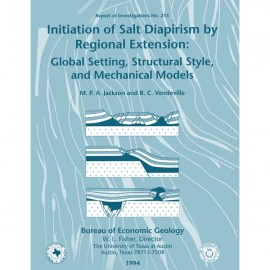Reports of Investigations
-
Books & Reports
- Reports of Investigations
- Guidebooks
- Udden Series
- Geological Circulars
- Down To Earth
- Atlases of Major Oil and Gas Reservoirs
- Texas Memorial Museum Publications
- Environmental Geologic Atlas of the Texas Coastal Zone
- Mineral Resource Circulars
- Other Reports
- Seminars and Workshops
- Handbooks
- Submerged Lands of Texas
- Symposia
- Annual Reports
- Open File Reports
-
Maps & Cross Sections
- Thematic Maps
- Miscellaneous Maps, Charts & Sections
- Geologic Atlas of Texas
- STATEMAP Project Maps
- Geologic Quadrangle Maps
- Cross Sections
- Highway Geology Map
- Energy and Mineral Resource Maps
- Shoreline Change and Other Posters
- Wilcox Group, East Texas, Geological / Hydrological Folios
- Bouguer Gravity Atlas of Texas
- River Basin Regional Studies
- Featured Maps
- Posters
- Teachers & the Public
-
Geological Society Publications
- Gulf Coast Association of Geological Societies
- Alabama Geological Society
- Austin Geological Society
- Corpus Christi Geological Society
- Houston Geological Society
- Lafayette Geological Society
- Mississippi Geological Society
- New Orleans Geological Society
- South Texas Geological Society
- GCS SEPM Publications
- Historic BEG & UT Series
RI0246. Conceptual Breakthroughs in Salt Tectonics: A Historical Review, 1856-1993, by M. P. A. Jackson. 51 p., 41 figs., 1997. Print.
To purchase this publication as a downloadable PDF, please order RI0246D.
ABSTRACT
This report subjectively reviews the chief conceptual breakthroughs in understanding salt tectonics. Each discovery and its implications are presented as simply as possible. The history of salt tectonics divides naturally into three parts, defined here as the Pioneering Era, the Fluid Era, and the Brittle Era.
The Pioneering Era (1856 to 1933) featured the search for a general hypothesis of salt diapirism, which was initially dominated by erroneous notions of igneous activity, residual islands, in situ crystallization, osmotic pressures, and expansive crystallization. Gradually data from oil exploration constrained speculation. The effects of buoyancy versus orogeny were debated; contact relations were characterized; the spectacular efficiency of salt as a geologic lubricant became evident in fold belts; salt glaciers and flow sheets were discovered; palinspastic restorations were attempted; and the concepts of downbuilding and differential loading were proposed as diapiric mechanisms.
The Fluid Era (1933 to ~1989) was dominated by the view that salt tectonics resulted from Rayleigh-Taylor instabilities in which a dense fluid overburden having negligible yield strength sinks into a less-dense fluid salt layer, displacing it upward. Density contrasts, viscosity contrasts, and dominant wavelengths were emphasized, whereas strength and faulting of the overburden were ignored. During this era, salt bulges between extremely disharmonic fold trains were investigated; salt upwelling below thin overburden was identified; internal structures of mined diapirs were discovered; peripheral sinks, turtle structures, and diapir families were conceived; flow laws for dry salt were formulated; and contractional belts on divergent margins and allochthonous salt sheets were determined.
The 1970’s revealed intrasalt minibasins, finite strains in diapirs, the basic driving force of salt allochthons, the possibility of thermal convection in salt, direct measurement of salt glacial flow stimulated by rainfall, and the internal structure of convecting evaporites and salt glaciers. The 1980’s revealed salt rollers, subtle traps, flow laws for damp salt, salt canopies, and mushroom diapirs; modeling explored effects of (1) regional stresses on domal faults, (2) spoke circulation, and (3) combined Rayleigh-Taylor instability and thermal convection. By this time, the awesome implications of increased potential for hydrocarbon reservoirs below allochthonous salt sheets had stimulated a renaissance in salt tectonics research.
Blossoming about 1989, the Brittle Era (~1989 to present) is actually rooted in the 1947 discovery that a diapir stops rising if its roof becomes too thick. Such a notion was heretical in the Fluid Era. Stimulated by sandbox experiments and computerized reconstructions of Gulf Coast diapirs and surrounding faults, the onset of the Brittle Era unveiled regional detachments and evacuation surfaces (salt welds and fault welds) along vanished salt allochthons, raft tectonics, and shallow spreading and segmentation of salt sheets. The early 1990’s revealed rules of section balancing for salt tectonics; salt flats and salt ramps; reactive Piercement as a diapiric initiator resulting from tectonic differential loading; cryptic thin-skinned extension; the influence of sedimentation rate on the geometry of passive diapirs and extrusions; the importance of critical overburden thickness to the viability of active diapirs; fault segmented sheets; roho systems and counterregional fault systems; subsiding diapirs; extensional turtle structure anticlines; and mock-turtle structures.
"The truth is that whoever touches this enticing subject . . . is bound to indulge freely in speculation. The problem is so broad, the factors involved are so numerous, and the work to be done with regard to salt structures is so great that we cannot . . .[restrict our speculation to the narrow] limits of exact knowledge."—Everett DeGolyer, 1925
"Although this is no place in which to describe the adventures of a petroleum geologist it may, perhaps, be said that the carrying out of the geological work referred to was greatly hampered owing to much of the time being spent as a prisoner in the hands of Italian, Turk and Arab."
—Arthur Wade, mapping salt domes on the Red Sea coast of Arabia in 1912
Keywords: contraction, diapirism, extension, faulting, halokinesis, history of geology, salt diapir, salt glacier, salt tectonics, scientific revolutions, structural geology, tectonic modeling
CONTENTS
ABSTRACT
INTRODUCTION
THREE ERAS OF SALT TECTONICS
The Pioneering Era (1856 to 1933)
Unconstrained Speculation
Mechanical Control of Salt Diapirism
Buoyancy
Regional Contraction
Erosional Differential Loading
Diapirs as Thrust Nappes
Salt Fountains and Salt Glaciers
Depositional Differential Loading
Downbuilding
The Fluid Era (1933 to ~1989)
Palinspastic Structural Restorations
Decollement Styles and Downward Salt Bulges
Peripheral Sinks
Internal Structures of Diapirs
Early Initiation of Salt Upwelling
Contractional Belts on Divergent Margins
Salt Nappe
Finite Strain in Diapirs
Thermal Convection and Salt Tectonics
Flow Rates and Salt Budget of a Salt Glacier
Internal Structures of Salt Glaciers
Perturbation of Doming Stresses by Regional Stresses
Salt Rollers
Subtle Traps
Flow Law for Damp Salt
Mushroom Diapirs
Salt Canopies
Rayleigh-Taylor Acme
The Brittle Era (~ 1989 to Present)
Physical Modeling Using Brittle Overburdens
Computerized Reconstruction
Major Detachments along Vanished Salt
Segmentation of Salt Sheets
Raft Tectonics, Salt Welds, and Fault Welds
Shallow Emplacement of Salt Sills
Shapes of Passive Diapirs and Submarine Salt Glaciers
Convergent and Divergent Gravity Gliding
Reactive Diapirism and Regional Extension
Diapiric Subsidence, Turtles, and Mock Turtles
Structural Systems of Allochthonous Salt Sheets
POSTSCRIPT
ACKNOWLEDGMENTS
REFERENCES
Figures
1.The first salt diapir described in the geologic literature
2. Posepny's schematic cross section, capturing some fundamental characteristics of salt diapirs
3. Depiction of a gallery in the Ignatzi Mine of Vizakna Dome, illustrating the similar-fold style characteristic of salt deformed by flow folding
4. Choffat's cross section through the valley of the Serra del Rei, illustrating the overturned collar of a Jurassic diapir comprising saliferous, gypsiferous Dagorda marl surrounding a block of county rock
5. The Spindletop gusher from the cap rock of a salt dome in coastal Texas
6. Features of the German salt domes
7. Mrazec's diapirs, which discordantly occupy the cores of folds in the Romanian Carpathians and thereby begged for a contractional origin
8. Yovanovitch's astonishingly perceptive cross section in the Rif nappes of Alpine age in Morocco, showing almost all the important characteristics of contractional salt tectonics
9. Characteristic geometries of Savon folds decoupling over Permian Zechstein salt
10. Stile's explanation of "harmonious" folding of beds of similar strength and salt tectonics as an extreme form of "inharmonious" folding of a sequence including a highly mobile bed
11. Lohest's physical models, using grease to illustrate the effectiveness of weaker layers like salt in decoupling deformation by buckling or thrusting of compressed strata above or below the weak decollement
12. Upwelling of Pennsylvanian-age Paradox evaporites by erosionally induced differential loading below the Colorado Canyon, Utah
13. Two types of evaporite thrust sheets identified by Busk that are still emerging from a laterally compressed carapace unroofed by erosion in western Persia
14. G. M. Lees' field sketch of Kuh-e-Anguru salt plug, Iran, visited in the early 1920's
15. Sedimentary differential loading demonstrated by a model of a subaqueous delta of sand
16. Barton's concept of diapiric downbuilding
17. Dawn of the Fluid Era, represented by Nettleton's gravitational overturn of a fluid-fluid system
18. An early example of detailed palinspastic restoration of salt tectonics in the Spanish Pyrenees
19. Two fundamental types of contractional salt tectonics
20. O'Brien's reconstruction of the growth of "salt bulges" comprising Miocene evaporites in the Masjid-e-Sulaiman area of southwestern Iran
21. The sedimentary record of salt tectonics, as systematically deciphered by Trusheim
22. Seismic evidence of upwelling of Jurassic Louann Salt below a thin overburden of Smackover carbonates
23. Afold belt, discovered on the continental slope of a divergent passive margin
24. The first known illustration of allochthonous salt
25. Sedimentary differential loading, imposed by the prograding continental margin, as the driving mechanism for the allochthonous Sigsbee salt nappe, Gulf of Mexico
26. Thermal convection as a mechanism for forming diapirs of salt within salt in the Danakil Depression of Eritrea
27. Glacial structures created by nonuniform flow of salt over an obstructing bedrock step in Kuh-e-Namak's northern salt glacier, Dashti, Iran
28. The salt roller
29. A wide variety of subtle traps associated with diapirism in different depositional environments
30. Concentric systems of downward-facing folds within mushroom-shaped diapirs, diagnosed in central Iran and Germany after being identified in centrifuged models
31. Coalesced salt bodies, first deduced as 2-dome structures on the basis of gravity modeling along the coastal Salina Basin, southwest Gulf of Mexico, then mapped as a 12-dome coalesced structure called a salt canopy in the Great Kavir of central Iran
32. Dawn of the Brittle Era
33. Another catalyst for the Brittle Era
34. The Wilcox Fault Zone, an example of a major detachment that created accommodation space because salt withdrew from beneath it, culminating in complete loss of salt
35. The concept of salt welding
36. Broad lateral flanges of Triassic evaporite, which Ehrmann interpreted as intrusive salt sills in the Gulf of Bejaia, Kabylie, Algeria
37. Onlap of frontal reflectors above a thin roof averaging only 100 m in thickness, the principal evidence of shallow emplacement of allochthonous salt tongues
38. Regional extension as an initiator of linear diapirs
39. Rise of a model reactive diapir due to tectonic differential loading induced by a graben formed by regional extension
40. The rise and fall of diapirs during thin-skinned regional extension, creating turtle-structure anticlines, mock turtles, keystone grabens, and fault welds
41. Schematic evolution of an allochthonous salt sheet into two end-member structural systems by seaward evacuation of salt during sedimentary loading
Citation
Jackson, M. P. A., 1997, Conceptual Breakthroughs in Salt Tectonics: A Historical Review, 1856-1993: The University of Texas at Austin, Bureau of Economic Geology, Report of Investigations No. 246, 51 p.
